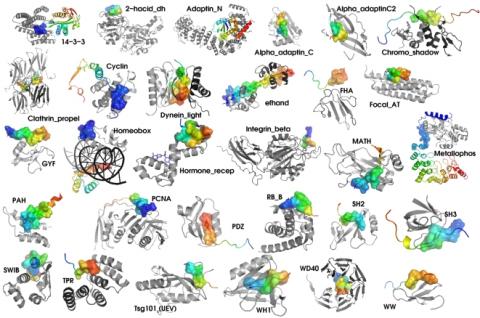Contextual specificity in peptide-mediated protein interactions

Stein A, Aloy P, Most biological processes are regulated through complex networks of transient protein interactions where a globular domain in one protein recognizes a linear peptide from another, creating a relatively small contact interface. Although sufficient to ensure binding, these linear motifs alone are usually too short to achieve the high specificity observed, and additional contacts are often encoded in the residues surrounding the motif (i.e. the context). Here, we systematically identified all instances of peptide-mediated protein interactions of known three-dimensional structure and used them to investigate the individual contribution of motif and context to the global binding energy. We found that, on average, the context is responsible for roughly 20% of the binding and plays a crucial role in determining interaction specificity, by either improving the affinity with the native partner or impeding non-native interactions. We also studied and quantified the topological and energetic variability of interaction interfaces, finding a much higher heterogeneity in the context residues than in the consensus binding motifs. Our analysis partially reveals the molecular mechanisms responsible for the dynamic nature of peptide-mediated interactions, and suggests a global evolutionary mechanism to maximise the binding specificity. Finally, we investigated the viability of non-native interactions and highlight cases of potential cross-reaction that might compensate for individual protein failure and establish backup circuits to increase the robustness of cell networks.
PLoS One,
2008, 3(7), e2524
Pubmed: 18596940
Direct link: 10.1371/journal.pone.0002524
